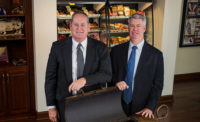In December 2016, Smithfield Foods — the world’s largest pork processor and hog producer — made known to the world its plan to reduce greenhouse gas (GHG) emissions by 25 percent across its entire supply chain by the year 2025.
The challenge that lay ahead was significant — but Smithfield wasn’t ready to back down or let this headline become an empty promise. Nearly a quarter of the way toward the deadline, Smithfield is already reaping the benefits of several major breakthroughs throughout its initiatives that have set it up for future success.
A goal such as Smithfield’s requires more than a few small changes here and there — though those smaller changes shouldn’t be discounted as they do add up. But such a lofty goal requires major advancement in strategy, operations, culture and technology in a variety of channels.
Plans to reduce GHG emissions began to focus on the agricultural side of the business. In collaboration with the Environmental Defense Fund (EDF), Smithfield began to look at fertilizer application on farms growing corn and soybeans to feed the company’s hogs. On those farms, oversight of the amount of nutrients applied to the land and crops is sometimes not as rigorous as, say, it is on Smithfield’s hog farms, explains Stewart Leeth, vice president of regulatory affairs and chief sustainability officer for Smithfield.
“[Those crop farmers] can go and simply buy chemical fertilizer and then apply it based on their best management practices or what their experience told them,” he says. “The farmer wants to maximize the yield on his or her farm. Environmental groups will tell you that contributes to over-application, and nutrients can either run off into surface water or cause air emissions in the form of nitrous oxide.”
With the help of EDF and an important customer also seeking to shrink its greenhouse gas footprint, Smithfield began helping these farmers optimize fertilizer use. Innovative agronomic principles and advanced technology were introduced, including, for example, equipment that can detect the nutrient load of the field it is surveying and apply the correct amount of fertilizer based on the readings it takes in real time as the tractor passes over the plants.
Leeth says this first step helped Smithfield create improved trust and build more relationships with farmers on the East Coast, allowing the company to shorten the haul for its feed.
“The hope has been — and I think it has been successful so far — to increase the supply of local grain coming to our grain facilities in the east, as opposed to importing more grain from the Midwest,” he says. The success of that portion of the GHG reduction initiative spurred Smithfield to think bigger, revisiting a challenge that had confounded the company for several years: converting hog manure to energy.
“We have tried dozens of projects over the years, with most of them not working to our standards,” he says. “We wanted to extract more value for those byproducts on our farms and create a new revenue stream for our family contract farmers.”
All of these projects, Leeth explains, followed a standard industry model by which waste was converted to energy at the local, single-facility level, and that energy would be fed into the grid. However, that approach never created enough energy to work well and was not economically viable.
“First, the manure we’re working with in the hog industry is primarily wet, so it’s a challenge to try and create sufficient amounts of gas that can be burned in an on-site generator,” he says. “Second, we have been very successful on feed efficiency, getting more energy from the feed into the hogs and less energy out in the waste.”
Still intent on finding a good solution, Smithfield expanded its vision to a larger concept. The project model turned to covered lagoons and digesters at the farm level, which pull methane gas from the waste and collect it — but rather than releasing the methane into the atmosphere or burning it on the farm in a generator, it is sent from each farm to a centralized facility, which stores it, treats it to meet gas-line quality standards, and injects it into the natural gas pipeline to power homes, offices and buildings across the country.
“The profile of this project has changed completely from a one-off small generator at a farm to this broader system, in which we’re creating gas at multiple farms, feeding into one collection point and putting it into the pipeline,” Leeth says. “What makes it really work for us and for our farmers is the market; it’s a renewable fuel and the monetary value is much higher than it is for commodity natural gas.”
The pilot gas collection facility sits centrally located among five Smithfield contract hog farms near Kenansville, N.C., and is a stand of vessels, pipes and biogas infrastructure. The gas arrives via small pipes from each of the farms, and then passes through filtration to remove impurities, which are flared off. Purified gas is stored in compression tanks and metered into the natural gas system.
To further advance the project, Smithfield entered into a joint venture with Virginia-based Dominion Energy to form Align Renewable Natural Gas (RNG)SM, which will manage expansion of the program to other Smithfield contract and company-owned farms in North Carolina, Utah and Virginia. Align RNG will handle construction of the pipelines to the farms, but the farm owners will be responsible for covering lagoons and/or installing digesters and other infrastructure on their property to convert the manure to methane and transfer it to the pipelines. Additionally, in Missouri, Smithfield is partnering with Roeslein Alternative Energy (RAE) to install biogas infrastructure across all company-owned finishing farms.
“It’s still early in the process, but we’re hopeful that our contract growers will be receptive and sign up to be a part of this,” Leeth says. “So far, it seems like they are, because it’s another income stream for them.”
Efficiency efforts
Another area in which Smithfield saw opportunity to make significant headway toward its GHG reduction goal was through its supply chain. With the size and scope of Smithfield, one might expect efficiency to be the norm for the company, but Dennis Organ, Smithfield’s chief operating officer, U.S. operations, says steps needed to be taken to unlock those efficiencies.
“The biggest thing that enabled us to be more efficient in the supply chain is the ‘One Smithfield’ initiative — we are one company rather than several different operating companies,” he explains. With this new, unified strategy in place, Smithfield embarked on a network optimization project, installing specialized software and training employees to model scenarios and ground all decisions with financials.
The software allowed Smithfield the visibility to see redundancies and inefficiencies across the supply chain: producing bacon in one plant only to ship it to another region, in which there were plants manufacturing the same bacon, for example.
“How could a system with that example times thousands of instances ever be efficient?” Organ asks. “Things don’t accidentally end up in an organized manner, and to me, that was the biggest impact because we have the visibility to understand these things now.”
Smithfield began chipping away at these opportunities to optimize its system, with each opportunity offering a sustainability benefit in reducing miles traveled or improving the efficiency of shipments. Being more strategic about where products are produced and delivered has created significant gains.
A few breakthrough initiatives have helped Smithfield find ways to increase the weight of its shipments, Organ relays. The company has done a lot of work to simplify the number of SKUs it carries and the types of boxes that carry the product. Additionally, trailblazing investment in lighter-weight trucks has played an enormous part in helping Smithfield put more product on each shipment, allowing for fewer trips.
“The difference between a 40,000-pound shipment and a 47,000-pound shipment doesn’t sound like that big of a deal — until you realize we sell 8.5 billion pounds of meat and ship even more than that between our facilities,” he explains. “These initiatives are responsible and innovative, and it only comes from the ability to view the financial impact of our actions.”
At the direct-store-delivery (DSD) level, Smithfield recently underwent a route optimization assessment for its fleet that resulted in a further reduction of miles traveled. Network optimization also has had a significant impact on the cold storage and distribution portion of the business — at one point in time, Smithfield had inventory in more than 110 locations, Organ says. Today, that number is down to fewer than 30 locations, offering the company an enormous savings across the board.
The most recent headliner of the optimization process was the grand opening of Smithfield’s brand new distribution center in Tar Heel, N.C., in December 2018. The state-of-the-art facility features nearly 50,000 pallet positions and has an annual capacity of more than one billion pounds, according to a company news release, and it is adjacent to the company’s Tar Heel processing plant.
Moving forward, Organ says the company plans to phase out corrugated combo bins in favor of reusable combos, which he believes could be a multimillion-dollar initiative. Leeth and Organ both mention that waste-reduction initiatives are well under way at all Smithfield facilities, with eight having achieved “zero-waste-to-landfill” status at presstime, and many more working toward achieving that classification as well. Although Smithfield’s size often guarantees that multiple simultaneous major initiatives will be in the works, when those initiatives are successful — as the aforementioned have been — they produce in a big way, especially now that the company is unified in its efforts.
“If we hadn’t consolidated under ‘One Smithfield’, we would have been in a much more difficult spot,” Organ says. With significant innovations already creating sustainability savings for the company, and a willingness to be innovative and try new ideas, Smithfield Foods has claimed a spot among the power players in the world of sustainability.
It will need to maintain that position to reach its lofty GHG reduction goal, but history demonstrates that betting against that achievement could be short-sighted, with all of Smithfield pushing hard in the same direction to reach it. NP








Report Abusive Comment